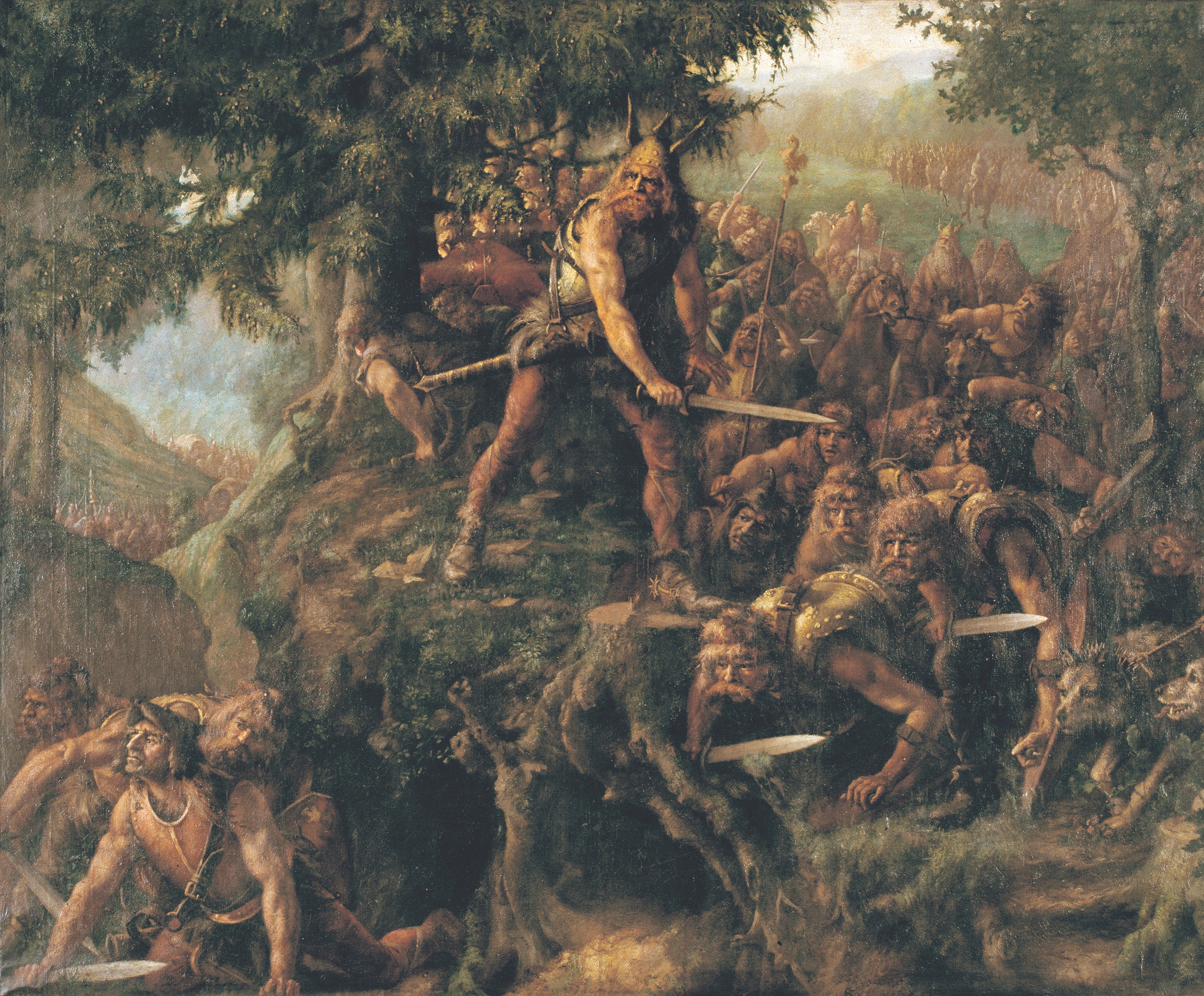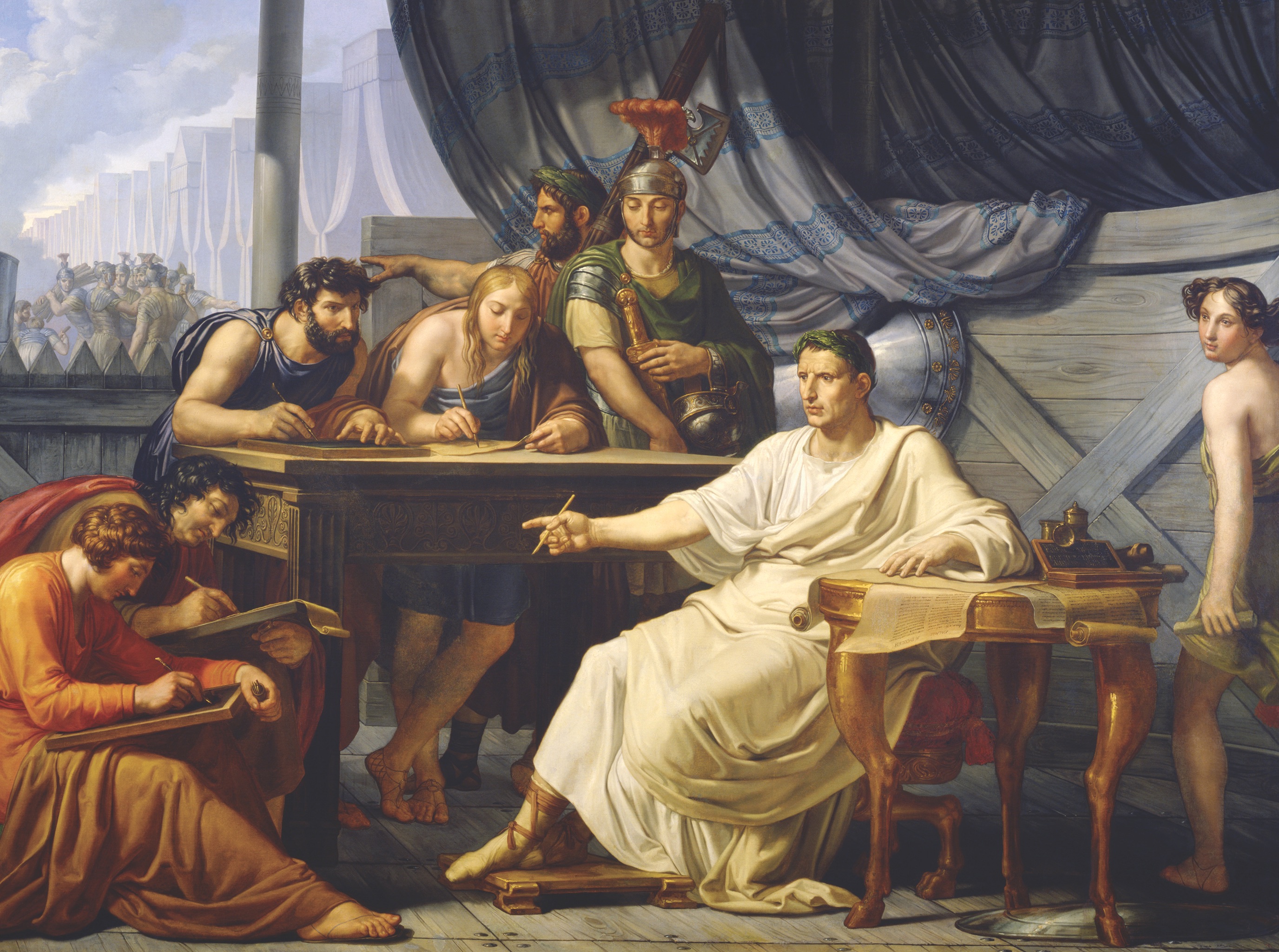We remember Gaius Julius Caesar from our schoolbooks for his conquest of Gaul, his consolidation of power over the Roman Senate and, ultimately, his betrayal and brutal murder at the hands of fellow Romans. Yet few are familiar with the Gallic wars Battle of the Sabis River, in which Caesar very nearly lost his army, his political ambitions and his life. Indeed, only his legionaries’ experience, training and individual initiative saved him from utter annihilation.

a lone Gallic warrior takes on a group of spear-wielding Romans. (Chateau de Versaille)
In 57 bc, his second year of campaigning in Gaul (centered on present-day France, Belgium and Luxembourg), Caesar focused on suppressing the northern tribes, either through diplomacy or by the sword. His legions had defeated the Helvetii confederation of Gallic tribes the previous year, and the general was determined to destroy any remaining rebel factions. That summer he faced his greatest obstacle in a tribal coalition led by the Belgic Nervii people, who refused to submit to Roman rule.
The leader of the Nervii, Boduognatus, had formed a Belgae/Gallic alliance of four tribes: Boduognatus’ own Nervii, the Atrebates, the Aduatuci and the Viromandui. The Aduatuci would not arrive in time to participate in the battle Boduognatus hoped would thwart the Roman advance, but the Nervii leader was still able to mass upward of 60,000 warriors, by Caesar’s estimate. Modern demographic analysis suggests half that number.
Boduognatus’ battle plan—to lay in ambush, then launch all-out assaults on individual legions, defeating Caesar’s army in detail—was tactically sound. The plan relied on the Roman convention of placing a baggage train between each legion while on the march. Such gaps in the column would allow the tribesmen time and space to annihilate the legions in sequence, before each trailing legion was able to maneuver around the preceding baggage train. The difficult, hilly terrain Boduognatus selected would grant his men the advantage of concealment, while the surrounding woods would restrict the legions’ mobility. If the tribesmen could seize the initiative and strike hard, they should be able to overwhelm the Roman troops. Boduognatus further hoped the legions’ systematic, piecemeal destruction and the sacking of the baggage trains would in turn send the famously disciplined legionaries into a panicked rout, forcing Caesar to withdraw to winter quarters. While his theory was sound, Boduognatus faced a formidable foe.
The Roman army comprised eight legions—the veteran VII, VIII, IX, X, XI and XII, plus the newly levied XIII and XIV—an estimated 42,000 men, roughly comparable to the Belgae/Gallic force. Caesar led his legions out of camp in mid-August. They marched down a narrow road preceded by a reconnaissance element tasked with finding Boduognatus’ forces. After three days’ march the scouts pinpointed the Nervii and their allies not 10 miles distant, on the far side of the Sabis River (the present-day Selle River in northern France, a dozen miles from the Belgian border). Caesar sent forward a reconnoitering party to select a suitable campsite.
Over the preceding days a number of ostensible Belgae/Gallic allies marching with the legions had melted away. This mass desertion created new concerns for Caesar. The defectors not only added valuable manpower to the enemy but also provided Boduognatus intelligence on the composition, strength and disposition of the Roman column. With the departure of the Gallic allies—predominately cavalry—the Romans also lost a greater part of their ability to gather tactical intelligence and screen the army’s movements. As they approached the waiting enemy, Caesar adjusted his formation to minimize the impact of that loss, keeping the remaining cavalry close to the marching legions to protect against ambushes and changing the standard marching order. On learning from more trustworthy informants that Boduognatus’ forces lay in wait before him, the Roman commander placed his six veteran legions out front and consolidated the baggage trains into a single column, with the two green legions serving as a rearguard.
Boduognatus had lost the element of surprise. But he had more surprises in store for the Romans.
Caesar’s army slowly filtered into the selected campsite atop a hill overlooking the Sabis, the terrain, foliage, trees and hedgerows restricting any wide-scale maneuvering. As each legion arrived, its commander sent out skirmishers to scout the surrounding woods, while quartering parties dispersed to gather wood and other necessities. Those remaining in camp dug trenches. Unknown to the Romans, the Nervii and their allies lay immediately south of the river, waiting for the baggage train to arrive before springing their concentrated ambush.
No sooner did the Roman scouts cross the Sabis than they made contact what they presumed to be a small band of mounted Nervii. In fact, the scouts had triggered Boduognatus’ own screening force. Using the woods for cover and concealment, the Nervii horsemen launched hit-and-run attacks—charging into and breaking up the Roman formations, only to retreat rapidly back into the woods. The clash between opposing skirmishers continued in this general pattern, the Romans reorganizing only to have the Nervii cavalry charge yet again. Far from incidental, the Nervii tactics worked to prevent discovery of the main Belgae/Gallic army, which awaited the signal to attack.
That signal finally came as Caesar’s consolidated baggage train arrived at the unfinished Roman camp. Moments later tens of thousands of screaming tribesmen surged from the broken terrain, shattered Caesar’s recon screen, splashed across the shallow river and charged headlong uphill toward the unprepared legionaries. The chaos Boduognatus had predicted spread though camp as the enemy rushed into their midst. Junior Roman commanders established hasty defenses wherever they stood. Legionaries—helmetless and half dressed for battle—engaged in hand-to-hand combat, while others fought unarmored in their marching kit. Unit commanders rallied troops around their standards, organizing available troops into ad hoc battle formations. Legionaries from different units flocked to the closest standard or commander, joining to form ersatz combat units in response to the mortal danger. Annihilation stared the Romans in the face.
Given the restrictions imposed on him by the terrain and vegetation, Caesar was unable to exercise any real command and control. He later admitted as much in his history of the Gallic wars. “As the enemy was so close and advancing so swiftly,” he wrote, “the [officers] did not wait for further orders but on their own responsibility took the measures they thought proper.” For the Romans this would not be a general’s fight, one guided by a plan and a single master. Instead, field-grade officers—legates and centurions—took command, rallying, organizing and counterattacking on their own initiative. As a result, the massive melee soon morphed into three separate actions.

On the Roman left flank Legions IX and X engaged the Atrebates. As that tribe had traveled the greatest distance to close with the enemy, its members entered combat somewhat fatigued. Marching toward the back of the lead element, the two legions benefitted from more time to gird themselves and thus responded effectively to the onslaught. As the Atrebates drew within range, both legions unleashed barrages of pila (javelins). The punishing hail repelled the Atrebates, pushing them back against the Sabis. Titus Labienus, commanding Legion X, pursued the fleeing enemy, followed by Legion IX. Pinning the Atrebates on the near bank of the river, the Romans shattered their morale and sapped their remaining strength. The pursuit continued across the river with similar results.
Fighting in the Roman center was tougher. There Legions VIII and XI locked in hand-to-hand combat with the Viromandui. Unfortunately for the latter, the Atrebates’ panic spread to the Viromandui ranks, which followed suit and fell back against the river. Like their comrades on the left, the legionaries dashed forward in pursuit of the tribesmen. Their eagerness had the unintended consequence of exposing the flank of Legions VII and XII on the Roman right.
Boduognatus and the Nervii, having closed with the Romans, noticed the break within the enemy line and rushed forward. The attackers split into two formations, one moving against the Roman camp, the other against Legions VII and XII. The result was the most confused fighting in a day filled with chaos. The Roman cavalry and slingers of the shattered recon screen returned to find the enemy in their camp, supporting their belief all was lost and prompting them to again flee, this time for good. Pressing the attack, Boduognatus and his Nervii warriors began to encircle the surviving Roman defenders. Things became so desperate that Caesar himself dismounted and took up arms in an effort to inspire his soldiers.
With Legions VII and XII beginning to falter due to the losses of both soldiers and officers, and given the increasingly apparent risk of envelopment, Caesar ordered the two legions to pivot and fight back to back. The new formation allowed them to be mutually supportive, each securing the other’s rear. With the possibility of attack from that sector mitigated, a sense of hope spread through the ranks of the surrounded legions. The Nervii continued to press the attack, but the overall Belgae/Gallic attack began to stall.
It was at that point the untested Legions XIII and XIV arrived on scene. Simultaneously, from the banks of the river Labienus recognized the plight of his beleaguered countrymen, reorganized Legion X and surged back uphill with a vengeance. The three converging legions cinched a noose around the Nervii. Though the tribesmen fought with a desperate courage, the Romans inexorably ground them down, slaughtering the enemy almost to a man. By day’s end, despite Boduognatus’ careful plans and timely execution, the tribal confederation he led was ultimately destroyed on the banks of the Sabis.

The only extant firsthand source on the battle is Caesar’s The Conquest of Gaul, in which he presents himself in a predictably flattering light (e.g., “Caesar had everything to do at once”). That said, it is apparent Boduognatus’ surprise attack haunted him. Likewise, Caesar inflates the number of likely enemy casualties, but readers get a clear sense he came razor close to losing the battle. And while Caesar’s after-action reports typically included lists of Roman casualties, particularly when very low, he omits any reference here to Roman losses. He likely did so for political reasons, controlling the narrative so as not to lose support among the powers that be in Rome. Reading between the lines of his battle account, it’s safe to assume Roman casualties were especially high among the embattled Legions VII and XII.
It also becomes clear Caesar’s victory was a credit not to his own martial prowess, but to the initiative and decisive actions of individual field officers and the disciplined response of rank-and-file legionaries. The Roman army of the era was professional, well-equipped, well-trained and highly disciplined. That the legionaries were able to organize quickly into ad hoc centers of resistance changed the momentum of the battle. Leaders capitalized on that instilled sense of cohesion, trusting that amid chaos each soldier would rally to a standard and fight together as one.
The Battle of the Sabis River stands as a textbook example of the importance of low-level leadership, individual discipline and overall professional training. Focusing on the smaller unit actions, one can plainly see the margin for victory rested on those three attributes. Were it not for that critical victory on the Sabis, there may not have been a siege of Alesia, an invasion of Britain, a second Roman civil war or even the celebrated Gaius Julius Caesar.
Major Benjamin Nagy is an Army infantry officer and the author of Maniple to Cohort: An Examination of Military Innovation and Reform in the Roman Republic. For further reading he recommends The Annals of Imperial Rome, by Tacitus; Caesar: Life of a Colossus, by Adrian Goldsworthy; and The Conquest of Gaul, by Julius Caesar.

